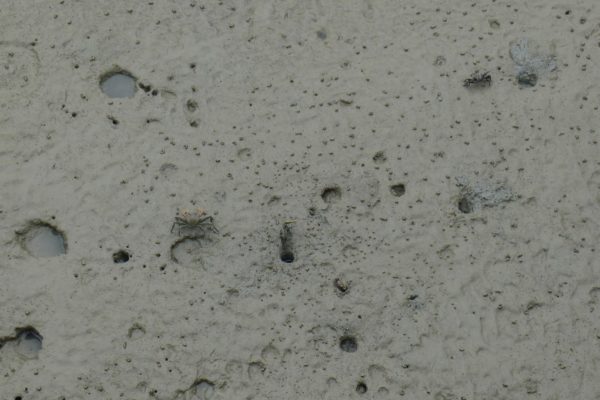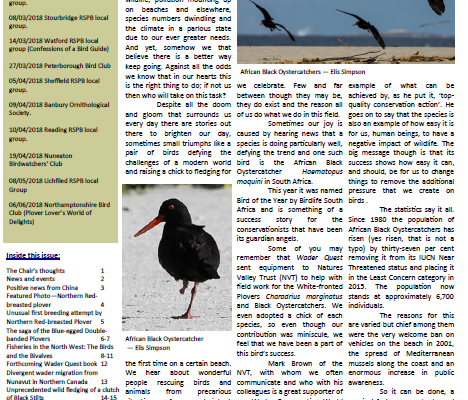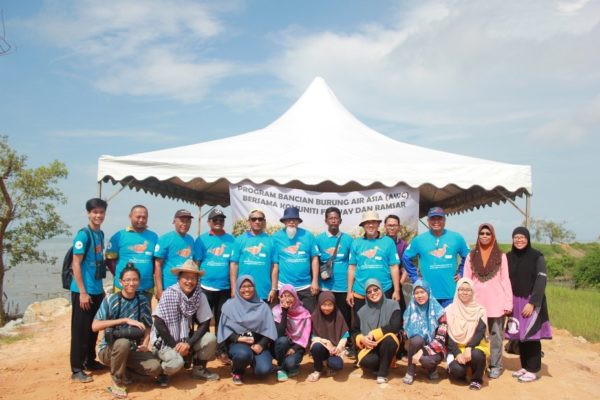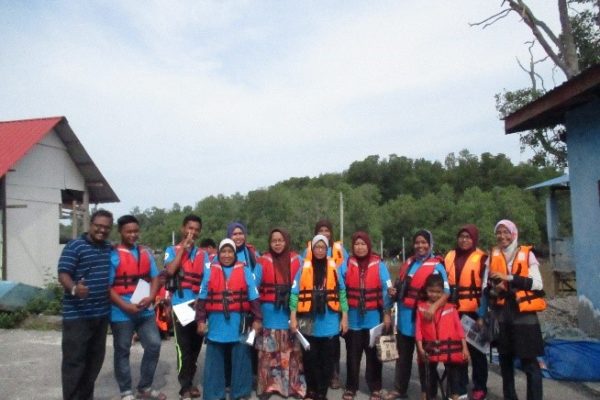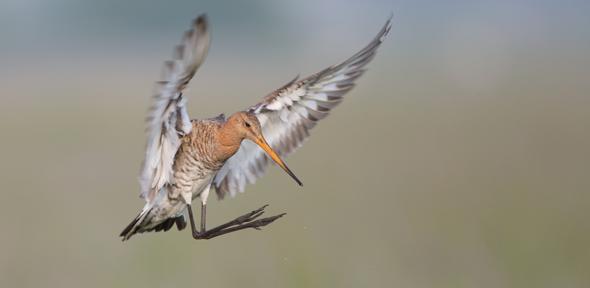-
Asian Waterbird Census with the Pulau Ketam Community
Posted by eaafp on March 12, 2018By Mr Woo Chee Yoong, Wildlife RA of the Malaysian Nature Society On the 15th until 19th of January, 2018, I was given the opportunity to engage the Pulau Ketam community in the Asian Waterbird Census (AWC) activity. The first task was to survey about the island community’s knowledge and interests in waterbirds. The second task was getting the community to be involved in the Asian Waterbird Census, AWC. Together with my MNS colleague, Ms. Agnes Loh, a local resident who is in-charge of the waste management project and Kelab Pencinta Alam (MNS School Nature Club) in Pulau Ketam, we went around the houses, shops, restaurants, secondary school and interviewed 100 villagers. I was lucky to meet some friendly and helpful members from the Chinese Chess Society (CCS) and they helped introduce me to the villagers, especially the fishermen who even took me on a boat ride for the roost site survey. On the second night, they spotted a few waterbirds at the jetty and informed me on the spot. The following weekend on the 28th of January was an introduction on AWC to the villagers. 16 villagers, with a majority of secondary school students, joined myself, Agnes and two MNS Selangor Branch bird group members, Mr. Low Kok Hen and Mr. Tang Tuck Hong. The two birders provided experiential knowledge of waterbirds to the villagers. We went out to the surrounding Klang Islands during low tide. The boatman brought us to a few good high roost sites. Overall from the survey, we found that the most waterbirds were Whimbrel (Numenius phaeopus), Common Redshank (Tringa totanus) and Common Tern (Sterna hirundo). We also counted 28 Lesser Adjutant (Leptoptilos javanicus). This is a listed Vulnerable species and the finding of this habitat is a crucial discovery. Other waterbirds recorded were the Common Sandpiper (Actitis hypoleucos), Common Greenshank (Tringa nebularia), Eurasian Curlew (Numenius arquata), Common Gull-billed Tern (Gelochelidon nilotica), Whiskered Tern (Chlidonias hybrida), Grey Heron (Ardea cinerea), Green-backed Heron (Butorides striata), Little Egret (Egretta garzetta) and Great Egret (Ardea alba). Besides waterbirds, there were lots of Brahminy Kite (Haliastur indus) circling around evening sky may be due to the tourism activity of raptor feeding. In my opinion, this is not an ethical way to promote tourism. It could disrupt the behaviour of the Brahminy Kite by feeding. Other than that, House Crow (Corvus splendens) can be heard everywhere in the village because of the accumulated rubbish without a proper solid waste disposal system and the villagers always complain of the noises these crows made. The other birds documented were Collared Kingfisher (Todiramphus chloris), Blue-tailed Bee-eater (Merops philippinus), Rock Pigeon (Columba livia) and Large-billed Crow (Corvus macrorhynchos). “It is not the bird watching skills that matters, but it is the interest and passion that we must instill inside each villager that counts. I hoped what we have done so far can help to inspire more villagers to volunteer their time in conservation, especially the youths that turned during the AWC. They are the ones who hold the future of this wildlife, if not them, who else? Thus, I would like to express my highest appreciation to MNS and all the warm-hearted Pulau Ketam community for the successful event held” mentioned Woo. Mangrove forest surrounding Pulau Ketam during the high tide. Fishermen boats at their own houses in Pulau Ketam. Abundant of crabs found at the jetty mudflat in Pulau Ketam that create the name for this village. Rubbish under the houses in Pulau Ketam. Members of the Pulau Ketam Chinese Chess Society.
Continue reading -
Wader Quest the newsletter (January 2018)
Posted by EAAFP communications on March 12, 2018Wader Quest the newsletter is the main publication of Wader Quest, which is a charity that aims to involve local groups and communities in Wader conservation.
Continue reading -
Asian Waterbird Census (AWC) with the Kampung Sungai Serdang Communities
Posted by eaafp on March 7, 2018Ms Nabilah Binti Jamaludin Community Research Assistant of Malaysian Nature Society (MNS) I had the opportunity to introduce bird watching activity to the Kampung Sungai Serdang community. At…
Continue reading -
Asian Waterbird Census (AWC) with the SG Buloh Sasaran Community
Posted by eaafp on February 27, 2018Ms. Anisah Ahmad Community RA of Malaysian Nature Society The Asian Waterbird Cencus (AWC) was held at Sungai Buloh Sasaran together with the community on 20th January…
Continue reading -
Waterbird Census in Sumatran Tiger Hot Spot
Posted by EAAFP communications on February 13, 2018Hizbullah Arief (Communication and Reporting Specialist at Sumatran Tiger Project) Yus Rusila Noor (Head of Programme, Wetlands International Indonesia) What do Sumatran tigers…
Continue reading -
Interview with a Winner of 2017 Knots Drawing Competition: A Young Birder in the Making
Posted by EAAFP communications on January 16, 2018Jeongsu Yuk, the Flyway Prize winner in category C of 2017 Knots Drawing Competition…
Continue reading -
不安定な政治情勢が種の損失をもたらす
Posted by EAAFP communications on January 3, 2018Read in English 2017年12月20日 ケンブリッジ大学(訳:天野達也博士) 世界の生物多様性について大規模な解析を行った研究により、人類の環境に対する影響を示す他のどの指標よりも、各国におけるガバナンスの有効性の低さが種の減少を最もよく説明することが示された。社会・政治情勢が不安定である国では、保護区の効果も望めないことが示されている。 過去30年に及ぶ世界の生物種の変化を調べた大規模な研究によって、経済成長や気候変動、人口増加など様々な要因の中で、各国におけるガバナンスの有効性の低さが種の減少を最もよく説明する要因だということが示された。 Nature誌に発表されたこの研究では、保護区は生物多様性の保全に有効であるものの、その効果は社会・政治情勢が安定している国でのみ得られるということも示されている。 この研究では、水鳥類の生息地である湿地生態系が地球上で最も豊かな生物多様性を維持している一方、現在最も脅威にさらされているという点に注目し、1990年からの水鳥種の動態を生物多様性全般の変化を表す指標として用いた。 ケンブリッジ大学が主導した国際チームによるこの研究では、全世界における2万6千の調査地で記録された461種の水鳥に関する240万件にも及ぶデータが解析された。 チームはこの巨大なデータを用いて、まず様々な国や地域における局所的な水鳥個体数の変化を定量化した。次にその結果と、各国における暴力発生率や法による支配、政治腐敗などガバナンスの様々な側面を指標化したWorldwide…
Continue reading -
Political instability and weak governance lead to loss of species, study finds
Posted by EAAFP communications on January 3, 2018Read in Japanese 20 December 2017 University of Cambridge Big data study of global biodiversity shows ineffective national governance is…
Continue reading -
FAO: Highly pathogenic H5 avian influenza in 2016 and 2017 – observations and future perspectives
Posted by eaafp on December 7, 2017The Food and Agriculture Organization of the United Nations released a 2017 November update on the highly…
Continue reading -
Wader Conservation World Watch 4 Special newsletter
Posted by EAAFP communications on December 1, 2017Wader Quest, a charity…
Continue reading

